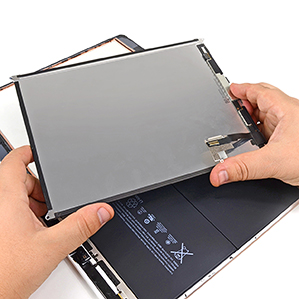我過去1984是SID會員. 對高解析度顯示器有點"研究"
2周前在台南用姪女的新iPAD時. 對其顯示能力稱奇.....今天知道是這玩藝
Lurking Inside the iPad Is the Future of High-Def Displays
The appearance of indium gallium zinc oxide transistors in iPads shows that the display industry is poised to begin churning out a new breed of high-performance screens.
By Mike Orcutt on November 14, 2013
 Case cracked: Teardown specialists who examined the latest iPads report that at least some are using a novel high-resolution display technology.
Case cracked: Teardown specialists who examined the latest iPads report that at least some are using a novel high-resolution display technology. One of the most important innovations in Apple’s latest iPads lies behind the screen. In many of the tablets, the pixels in the display are controlled by transistors made of a material called indium gallium zinc oxide (IGZO), a promising replacement for the conventional amorphous silicon.
Displays featuring “backplanes” of IGZO transistors should make it possible for tablets and TVs to have much higher-resolution displays while consuming significantly less power. The technology has already cropped up in low volumes of high-end smartphones and televisions, but its appearance in iPads suggests we can expect IGZO to improve several more popular products over the next year.
Display makers are racing to produce screens with ever-higher resolution, including ones based on organic light-emitting diodes (OLEDs), which promise not only a better picture but also greater power efficiency and compatibility with flexible form factors. But the display makers have run up against the physical limits of amorphous silicon, because electrons don’t move through that material fast enough. If transistors can be made from a material with a higher degree of “electron mobility,” the transistors can be smaller, making it possible to pack more pixels into a given space.
The highest-resolution smartphone screens already feature an alternative material called low-temperature polysilicon (LTPS). But LTPS panels are relatively expensive to make, and the fabrication method has proved difficult to adapt to displays larger than those on phones. IGZO transistor arrays are cheaper to make, and the manufacturing method is more compatible with larger screens. Though electrons don’t move through IGZO as quickly as they do through LTPS, IGZO’s electron mobility is still 10 times better than amorphous silicon’s. This means IGZO can be used to efficiently run OLED pixels, which require more current than their LCD counterparts.
Not all of the latest iPads have IGZO displays; in fact, it’s not entirely clear how many of the tablets have the technology. Luke Koo, senior manager of a team in Seoul that tears down devices for the IHS research firm, says IGZO-based displays made by Sharp are in at least some iPad Minis. Jennifer Colgrove, the lead analyst at Touch Display Research, also says Sharp is supplying IGZO displays for Apple tablets, but she is unsure whether they are in the Mini, the larger iPad Air, or both. Another Apple supplier, LG Display, can now mass-produce IGZO panels and is making them for its 55-inch OLED TV, Colgrove says.
By analyzing the power consumption of the iPad Air, Raymond Soneira, the founder of DisplayMate Technologies, found something unusual: its display uses 57 percent less power than the previous generation of iPads. That tells him the display “simply can’t be amorphous silicon,” though it’s possible it uses LTPS and not IGZO.
Apple did not return messages seeking comment.
No matter how extensively the iPads are using IGZO, it’s clear the technology is finally gaining momentum after years of manufacturing challenges. Among other problems, it has been hard to produce transistors, which are made by depositing thin films of various materials, with the necessary uniformity.
Last month, however, semiconductor equipment maker Applied Materials announced the release of new manufacturing tools that the company claims will address the uniformity problem and other challenges. It says it is working with several unnamed companies to ramp up manufacturing capacity. The technology is compatible with glass panel sizes used in both tablets and televisions, says John Busch, general manager of a display group at Applied Materials.
沒有留言:
張貼留言